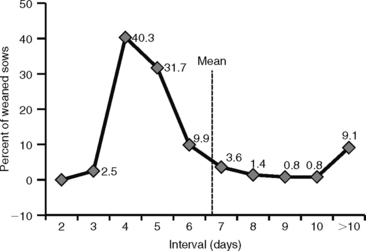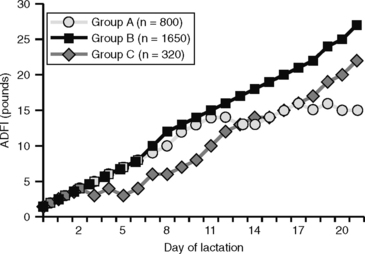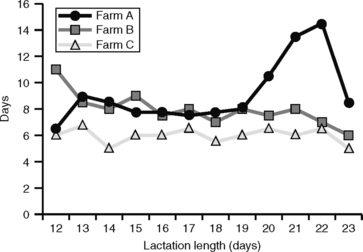CHAPTER 102 Infertility Associated with Abnormalities of the Estrous Cycle and the Ovaries
Various reports have demonstrated the role of infectious agents in porcine reproductive failure. For most infectious agents, researchers and veterinary practitioners have elucidated the pathogenesis, modes of transmission, and reasonably effective control programs. By contrast, porcine reproductive and respiratory syndrome virus (PRRSV) disease continues to be difficult to control, and the swine industry recognizes the economic impact of the virus on all phases of production. PRRSV disease continues to be detrimental to reproductive performance in sow herds, with variable severity of clinical signs in affected animals. With these widespread problems associated with PRRSV, pig producers often attribute reproductive failure to the virus when in fact the underlying causes are noninfectious. Unfortunately, the precise pathogenic mechanisms of noninfectious causes of reproductive failure also are elusive, and the interactions between the various factors affecting reproduction create major challenges to any efforts to improve the performance of the breeding herd.
PROLONGED WEANING-TO-ESTRUS INTERVAL
Most pig producers attempt to have 95% (or more) of sows bred within 7 days after weaning (Fig. 102-1). Producers strive to achieve this goal to minimize the number of nonproductive sow days (NPSDs). An NPSD is a day on which a sow is not pregnant or lactating, and the number of NPSDs is recognized as an economic loss to the producer. The ability to have the vast majority of weaned sows bred within a week is helpful to maintain the integrity of breeding groups and provides a natural synchronization of estrus for breeding programs. In addition, the results of several studies indicate that the fertility, as measured by farrowing rate and litter size, is less in sows returning to estrus after 7 days than in sows that returned to estrus within 4 to 6 after weaning. It was suggested that animals returning to estrus 7 to 10 days after weaning are “subfertile.”1 Under certain circumstances, it may be warranted to postpone breeding these animals until the second postweaning estrus (i.e., skip a heat).
Factors affecting the sow’s ability to return to estrus after mating have been were reviewed.2 The onset of estrus may be hastened or delayed, depending on the quality of management in both the breeding and the farrowing facilities. For example, sows consuming insufficient feed or feed with suboptimal energy or protein content during lactation in the summer months have longer WEI than sows with optimal feed and nutrient intake. Evidently, diminished feed intake during the first week of lactation, the last week of lactation, or throughout lactation contributes to postweaning reproductive failure.3 It is apparent that the greatest challenge is to ensure sufficient feed intake by primiparous sows (Fig. 102-2). To overcome the problem of suboptimal energy intake, fat (5% of the diet) is added to feed to increase caloric intake. The protein and amino acid requirements of highly prolific sows also may require adjustments, particularly primiparous sows nursing large litters of piglets. In regard to daily feed intake, feeding schedules for lactating sows typically are adjusted to provide fresh feed at least three times a day. Furthermore, evaporative cooling is used in the farrowing rooms to improve feed intake during the summer months.
Various weaning strategies, based on the removal of suckling-induced inhibition of follicular growth, have been used to shorten the WEI. Weaning the heaviest half of a litter 2 days early shortened WEI, and when this split weaning was initiated early enough (at 5 days), the WEI was reduced to 1 to 2 days.4 Potential benefits of this technique are to shorten WEI and to create a more synchronous return to estrus. The increased synchrony of estrus facilitates breeding and artificial insemination (AI) programs. Litter-sow separation (altered suckling) for 6 to 12 hours each day shortened the WEI if the previous WEI was longer than 6 days. This technique is labor intensive and provides limited advantages to pork producers.
A previous study indicated that the WEI is inversely related to lactation length.5 This correlation generally is accepted; however, females of most genetic lines and parities can be weaned at 14 days or earlier and return to estrus within 7 days.6 The most extreme example of short lactation length is the “zero-weaned” sow. Piglets are removed from these sows at birth. One investigation demonstrated that many of these animals will return to estrus at 14.8 ± 0.5 days after birth/weaning.7 Although lactation length has the potential to lengthen WEI, most modern sow farms routinely wean piglets from sows at less than 21 days. The possible negative influence of short lactation length must be assessed for each farm (Fig. 102-3) and compared with the potential economic benefits of the early-weaning sow.
Numerous exogenous hormone preparations have been assessed for inducing estrus in the postweaning sow; however, an equine-human chorionic gonadotropin (eCG/hCG) combination, PG600, has received the greatest attention. It was suggested that the administration of PG600 to sows at weaning reduced the WEI and the incidence of anestrus in postweaning sows, if a problem existed on the farm.8 Subsequently, it was revealed that PG600 treatment of postweaning sows reduced the WEI from 7.8 ± 0.6 days to 6.0 days and from 6.4 ± 0.7 to 4.7 days in first- and second-parity sows, respectively, during the summer months.9 These studies indicated that potential benefits could be obtained by using PG600 in postweaning sows, particularly in the summer. It is essential to conduct on-farm trials with any exogenous hormone combination to demonstrate its cost-effectiveness.
The most common problem with the control of estrus and ovulation in the postweaning sow is the inability of personnel to detect the onset of estrus. Without appropriate boar exposure, it is extremely difficult or impossible to adequately assess estrus in the pig. Recently, it was demonstrated that 10 minutes of daily contact between postweaning sows and mature boars reduced the WEI. In fact, 10 minutes of daily contact between postweaning sows and estrogenized “estrous” females reduced the WEI in a fashion similar to that for sow-boar contact.10 Obviously, estrus control requires certain behavioral and physical cues between animals.
Stay updated, free articles. Join our Telegram channel

Full access? Get Clinical Tree





 ; farm C,
; farm C,  ). The interval for each lactation day represents the mean of 100 to 400 observations. Most animals returned to estrus and were mated within 7 days of weaning. It was evident that lactation length had minimal effects on weaning-to-estrus interval (WEI) and WCI in farm C. By contrast, sows with a lactation length greater than 20 days had extended WEI and WCI in farm A. Sows with a lactation length less than 12 days tended to have a WEI greater than 7 days, with considerable sow-to-sow variation (data not shown) in the three farms.
). The interval for each lactation day represents the mean of 100 to 400 observations. Most animals returned to estrus and were mated within 7 days of weaning. It was evident that lactation length had minimal effects on weaning-to-estrus interval (WEI) and WCI in farm C. By contrast, sows with a lactation length greater than 20 days had extended WEI and WCI in farm A. Sows with a lactation length less than 12 days tended to have a WEI greater than 7 days, with considerable sow-to-sow variation (data not shown) in the three farms.